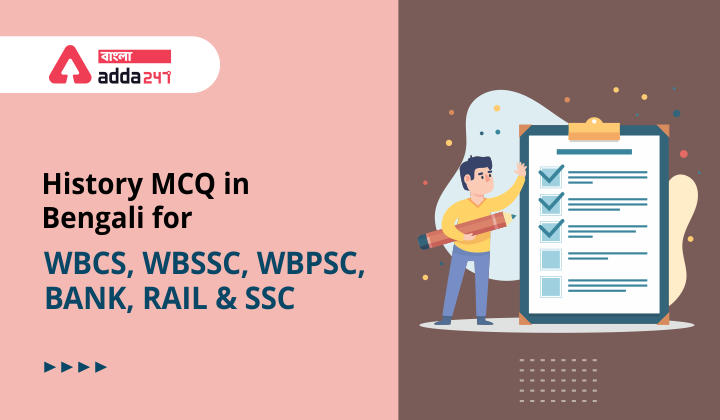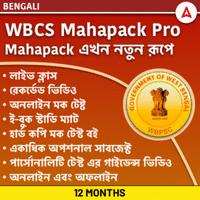History MCQ in Bengali: Welcome to Adda 247. ADDA 247 Bengali is giving you History MCQ in Bengali for all competitive exams including WBCS. Here you get Multiple Choice Questions and Answers with Solutions every day. Here you will find all the important questions and answers that will help you increase your knowledge and move you toward fulfilling your goals. Study these History MCQs regularly and succeed in the exams.
| History MCQ in Bengali | |
| Topic | History MCQ |
| Category | Daily Quiz |
| Used for | WBCS Exams |
History MCQ
Q1. “গো ব্যাক টু বেদাস” এই স্লোগান দিয়েছেন
(a) রামকৃষ্ণ পরম- হংস
(b) বিবেকানন্দ
(c) জ্যোতিবা ফুলে
(d) দয়ানন্দ সরস্বতী
Q2. কে ভারতে পিটস বিল প্রবর্তন করেন:
(a) ক্লাইভ
(b) হেস্টিংস
(c) ওয়েলেসলি
(d) কর্নওয়ালিস
Q3. নিচের মধ্যে কাকে সরোজিনী নাইডু “হিন্দু-মুসলিম ঐক্যের দূত” হিসেবে উল্লেখ করেছেন –
(a) আব্দুল গফফার খান
(b) মহম্মদ আলী জিন্নাহ
(c) শওকত আলী
(d) মৌলানা আজাদ
Q4. তেইশতম জৈন তীর্থঙ্করের সঙ্গে যুক্ত ছিল-
(a) বৈশালী
(b) কৌশাম্বী
(c) বারাণসী
(d) শ্রাবস্তী
Q5. কে স্বাধীন বাংলা রাজ্য প্রতিষ্ঠা করেন?
(a) ইলিয়াস
(b) হোসেন শাহ
(c) মুর্শিদকুলী খান
(d) আলীবর্দী খান
Q6. ভারতের রাষ্ট্রীয় প্রতীকে “সত্যমেব জয়তে” শব্দগুলি থেকে নেওয়া হয়েছে
(a) মুণ্ডক উপনিষদ
(b) সাম বেদ
(c) ঋগ্বেদ
(d) রামায়ণ
Q7. হরপ্পা সভ্যতা আবিষ্কৃত হয় :
(a) 1935 সালে
(b) 1942 সালে
(c) 1901 সালে
(d) 1921 সালে
Q8 নালন্দা বিশ্ববিদ্যালয় ছিল শিক্ষার একটি বড় কেন্দ্র, বিশেষ করে
(a) বৌদ্ধ ধর্মের
(b) জৈন ধর্মের
(c) বৈষ্ণব ধর্মের
(d) তন্ত্রের
Q9 পশ্চিম ভারতে চালুক্য রাজবংশের উত্তরসূরী কে?
(a) চোল
(b) কাকাতিয়
(c) পল্লব
(d) রাষ্ট্রকূট
Q10. নিচের কোনটি বৌদ্ধদের পবিত্র গ্রন্থ?
(a) উপনিষদ
(b) বেদ
(c) ত্রিপিটক
(d) জাতক
History MCQ Solutions
S1. Ans.(d)
Sol. “Go back to Vedas” slogan Given by Dayanand Saraswati.DayanandSaraswati was an Indian religious leader and founder of the Arya Samaj, a Hindu reform movements of the Vedic dharma.
S2. Ans.(b)
Sol. He introduced the Pitts Bill in 1784 with an objective to provide better regulation and management of the company as well as British Possessions in India.
S3.Ans.(b)
Sol. Jinnah began his political career showing the most ferocious will to forge unity between Hindu & Muslim Indians. Naidu, who compiled Jinnah’s speeches & writings in 1918 gave the volume the sub-title ‘An Ambassador of Unity’ & wrote that he stood “as an embodied symbol of Hindu-Muslim unity.
S4.Ans.(c)
Sol. TirthankarParshvanath was the son of king Ashvasena and queen Vama of Varanasi. He achieved Nirvana on the SammetSikhar. He lived in Varanasi around 800 BC. Parsvanatha is the 23rd Jain Tirthankar.
S5.Ans. (c)
Sol. MurshidQuli Khan founded independent state of Bengal. MurshidQuli Khan united his force and position and in the year 1719 he renamed his capital city from Makhsusabad to Murshidabad after his name.
S6. Ans.(a)
Sol.”Satyameva Jayate” is a mantra from the ancient Indian scripture Mundaka Upanishad.
S7. Ans.(d)
Sol. Alexander Cunningham published the first Harappan seal (with an erroneous identification as Brahmi letters). It was half a century later, in 1912, that more Harappan seals were discovered by J. Fleet, prompting an excavation campaign under Sir John Hubert Marshall in 1921-22 and resulting in the discovery of the civilization at Harappa by Sir John Marshall, Rai Bahadur Daya Ram Sahni and MadhoSarup Vats, and at Mohenjo-daro by Rakhal Das Banerjee, E. J. H. MacKay, and Sir John Marshall.
S8. Ans.(a)
Sol. Nalanda was a Mahavihara, a large Buddhist monastery, in the ancient kingdom of Magadha (modern-day Bihar) in India. The site is located about 95 kilometres southeast of Patna near the town of Bihar Sharif, and was a centre of learning from the fifth century CE to c. 1200 CE. It is a UNESCO World Heritage Site.
S9. Ans.(d)
Sol. In the western Deccan, the rise of the Rashtrakutas in the middle of the 8th century eclipsed the Chalukyas of Badami before being revived by their descendants, the Western Chalukyas, in the late 10th century.
S10. Ans.(c)
Sol. Tripiṭaka, also referred to as Tipiṭaka, is the traditional term for the Buddhist scriptures. The version canonical to Theravada Buddhism is often referred to as Pali Canon in English.




